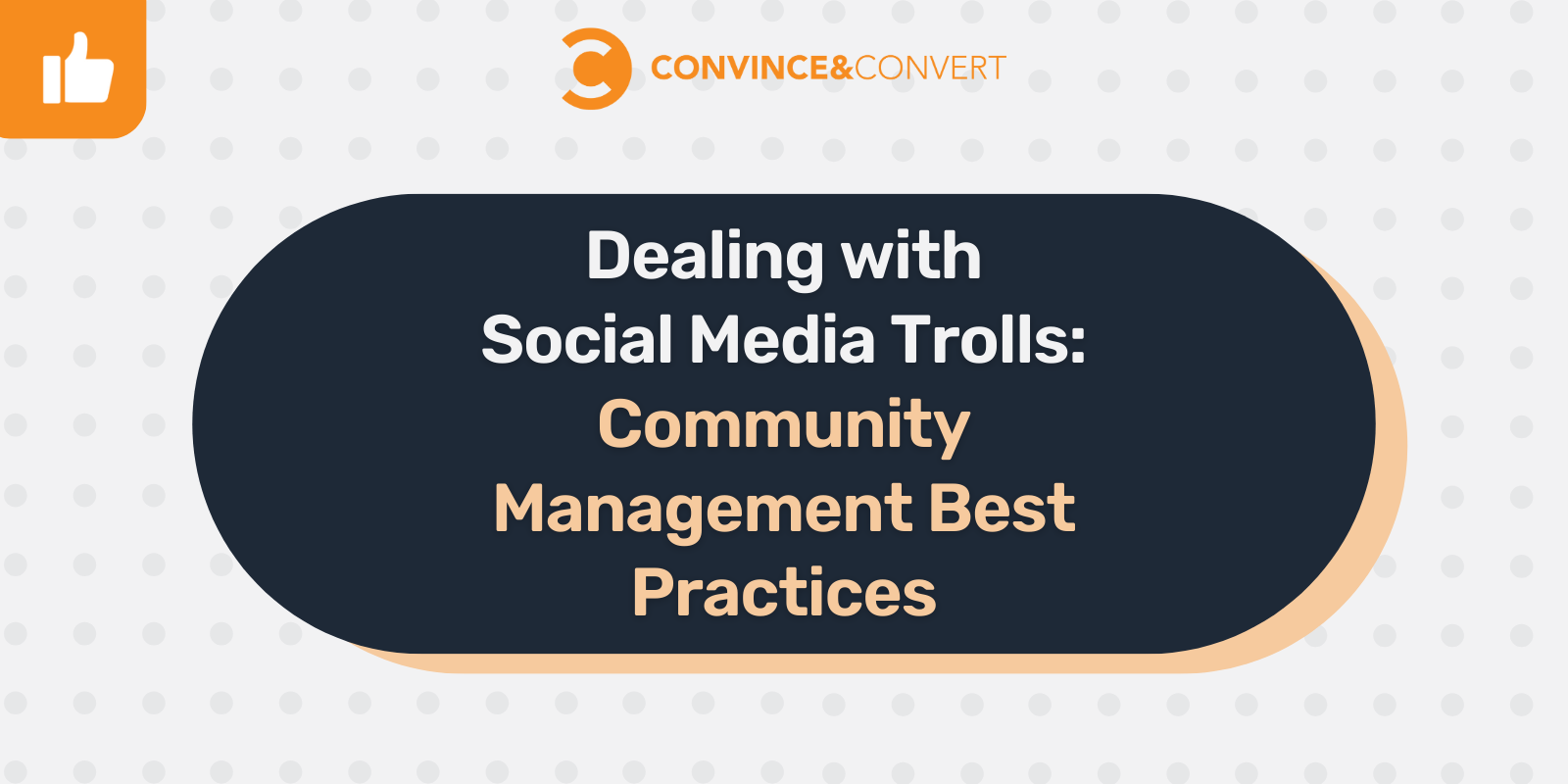
Dealing with social media trolls? Wondering what to do when the comments on your brand posts get hijacked or spiral out of control? Update your Social Media Community Management Guardrails!
While having a guidelines document is essential when it comes to marketing best practices, your brand’s social media moderation resource is only valuable if it’s both up-to-date and comprehensive. When done correctly, it should be both quick and easy for your social media manager(s) to know exactly what to do when social media hot topics infiltrate into your brands’ owned channels.
The Basics — and Benefits — of Social Media Community Management Guardrails
First, let’s revisit the basics: A Social Media Community Management Guardrails document is a guide that’s designed to help your team quickly and consistently respond to any frequent or anticipated questions, positive or negative comments, and customer support or care-centric needs.
It should include the brand’s voice and tone, as well as sample responses and a decision-tree for who and how to escalate serious issues. It should also be crystal clear in outlining when it’s appropriate to hide, delete, block, or ignore a user or comment. (Sometimes, the best response is no response, after all.)
The benefits? By having clear rules and your brand Do’s and Don’ts published and maintained, you can:
- Enable your social media manager(s) to spend less time thinking up responses from scratch or asking leadership and legal for guidance on tricky situations.
- Help ensure consistency in responses, which is vital for branding, customer care, and perceived fairness.
- Foster a safe and positive online environment for your followers, by actively moderating content and comments (and efficiently filtering out inappropriate or offensive material).
- Combat misinformation by addressing and correcting any misconceptions.
- Maintain the integrity of your brand, by building trust and demonstrating your channels as the one true source of product and services information.
- Be prepared for crisis management. By outlining steps and escalation procedures, you’ll be ready to tackle any emergencies or issues that arise with speed and transparency.
- Going above and beyond these basics is how you can truly ensure marketing best practices when dealing with the wild, wild west that is the worldwide web.
The Silly and Serious Sides of Social Media Trolls, Hot Topics, and Chatter
Would your team know how to handle these increasingly triggering social media topics?
On the volatile-yet-flippant side of things, we’re seeing a lot of chatter lately on:
- “OMG, I can’t stand when people treat their dogs like kids. Dogs aren’t children!”
- “OMG, I’m so sick of Taylor Swift. She’s (overrated) (ruining the NFL) (faking it).”
- “OMG, this is so staged!” (“No, it’s not!”) (“Yes, it so IS!”)
- “OMG, she’s such an Almond Mom.”
However, there are much more serious threads and topics popping up daily that all brands should be poised and ready to deal with. Deeper discussion topics may involve:
- Anything to do with elections or politics…
- Anything to do with Palestine and Israel…
- Anything to do with womens’ reproductive rights…
- Anything that could be deemed as violent, threatening, or bullying…
Let’s dive into how you can quickly and thoroughly update your social media managers’ resource “bible” to cover (almost) anything and everything that comes up on modern-day brand social channels.
Pro Tip: Real Life Moderation Example #1
Situation: Let’s say you just launched a BIG new product. One of your followers does not like the design. They post a polite but negative opinion, accordingly. What do you do?
Approach: While it stings to get a negative reaction to a high-priority brand post, it is not wise to delete, hide, block or dispute the comment. People are entitled to their opinions and scrubbing your social media channels of any negativity is disingenuous at best and shady at worst.
Ideally, your social media manager would consult your Guardrails and ask themselves, “Is this comment threatening? Violent? Bullying? Spam-level repetitive? If the answers are no, best practices say the comment stands. And as a social media veteran, I’d go a step further and “kill ‘em with kindness” by responding with something like:
Response Example: “Hey, (Name)! So sorry to hear you’re not liking our new design. We hope you’re able to find something else in our line-up that brings you joy! Have a great day.”
This not only shows them–and other fans–that you care and are paying attention to the channel by engaging, you also diffuse the negativity and hopefully reduce the chance of additional complaints and pile-ons.
Exceptions above? One response is enough. If they keep going and posting, stop feeding the beast by letting your original response lie. You’re not going to change their mind and the more you respond, the more likely it is that the exchange will end up in your Top Comments. If they start spamming your account with a negative comment on multiple posts and rapid-fire trolling, that’s when you can decide if/when to block them. And again, this should allllll be outlined in your Guardrails, re: what decision-tree steps to take.
How to Update and Optimize Your Brand’s Social Media Community Management Guardrails
- Make sure you’re covered on the basics. Now is a good time to confirm you’ve got all the key elements and“guts” of your Guardrails in place, including:
- Brand Voice and Tone
- Brand Persona: Who is the “personality” behind your brand social media channels? Often, it’s helpful to define a name, gender, age, and characteristics to further bring your brand Voice and Tone to life in day-to-day social media exchanges. (This is especially true if/when you have multiple social media managers or community managers handling multiple accounts.)
- Answers to FAQs (Frequently Asked Questions)
- Sample Responses for both Positive and Negative Comments
- Guidance on how to handle Customer Service inquiries and needs
- Do’s and Don’ts on how to communicate about Products and Services
- What NOT to do or respond to
- Qualifications for when to (delete) (hide) (block) posts or users that are demonstrating violent, threatening, bullying, or spam-level repetition.
- Crisis Escalation steps: Who to contact, how, and when for emergencies, severely negative or trending situations, or crises not covered or clear in standard day-to-day operations.
- Processes and reminders for curating UGC (user-generated content) and EGC (employee-generated content) and resharing/disclosing influencer content.
- Take active social listening and translate findings into your guidelines:
- Social media conversations are a two-way street. Make sure your team is monitoring comments, questions, mentions, tags, and direct messages. If/as topics become repetitive, add them to your FAQs and sample responses in your Guardrails. Track sentiment trends and respond accordingly.
- Create sample responses to anticipated news events:
- In addition to sentiment analysis, take a proactive approach to topics that may pop up on your channels even if they haven’t yet already.
- Get your team together to brainstorm and define potential questions, complaints, news events, and upcoming happenings.
- Craft and obtain pre-approvals on the sample responses and social media guidelines.
- Invite Customer Service into your inner circle:
- Make sure your social media and customer service teams are connecting regularly. When resources are tight and time is limited, it’s easy to fall into a pattern of only talking if/when there’s a complaint.
- Instead, hold weekly or monthly meetings to share the good and the bad. Take topics that come up more than a couple of times and add them to your Guardrails.
- Revisit your company’s banter style and what your brand should (and should not) engage with:
- If you’re seeing more and more of your comments becoming heated, snarky, or simply humorous, revisit what your “banter style” is with your brand marketing team. Sometimes, a little bit of a rib or riff can be light-hearted and can even go viral. (Think Wendy’s.) But usually, less is more when representing a professional business. Decide who your brand is and how it should respond, in both good and bad situations.
- Schedule times for regular reviews and updates for your Guardrails:
- Come together at least once a quarter and refresh your Social Media Guidelines with fresh eyes and with every key stakeholder. All too often, senior executives and C-suite leaders don’t realize just how many customer interactions take place on a daily basis on social media. Your community managers are on the front lines and can have a very real impact — positively or negatively — on your bottom line.
- This warrants, at a bare minimum, keeping your Guardrails top of mind and on the leadership agenda at least four times a year.
- Ensure training and usage of your Guardrails among social teams:
- Whether your social accounts are managed internally or outsourced to agency partners, your Social Media Guidelines are only useful if they are used!
- Make sure there’s a fail-safe training process and onboarding steps completed for each and every person that has access to your channels.
- And just like the above point about updating your Guardrails on a quarterly basis, it is smart to also review any updates or important points with your social team each quarter as well.
- Your community managers are “on” 24/7/365. It’s a tiring role that can often lead to burnout at worst and autopilot at best. Trust them to do what they do best without micromanaging, but use these quarterly Guardrail updates and reviews as your teams’ “tune-up” and as a way to check-in, connect, and gauge how things are feeling both internally and externally.
Pro Tip: Real Life Moderation Example #2
Situation: One day, you get a scathing direct message from a customer who has had a bad experience with your brand. They’re REALLY mad. You respond and offer whatever solution(s) your Guardrails dictate. Instead of fixing the issue though, they take their gripes to your public comments and/or to a ranting video in which they tag and mention you.
Approach: Even though it can be annoying to publicly deal with a customer service issue that you already tried to resolve in private, it’s super important to do so (and quickly.) By letting the complaint remain unaddressed, you’re signaling to your customers that you don’t care and that you don’t resolve issues quickly. (No bueno x2!)
However, it is totally fair to nod to the fact that this is not your first attempt to make it right. Encourage them to take it back offline and wrap it up with a smile!Response Example: “Hi, (Name)! We messaged you back as well and once again, we apologize for letting you down. (Situation) is just not the experience that we want you, or any of our loyal customers, to have with us. So that we may best assist you, please direct message us with more information or email us at abc@xyz.com. We’re here to help! Have a great rest of your week.”
One thing is for sure: We’re in for a lively year of social commentary. Are you ready?
What did we miss? What else do you do to keep your Social Media Guardrails documentation up-to-date and useful? Let us know on our Convince & Convert Facebook or Instagram channels.
Need help with creating your social media guidelines or future-proofing them with updates? Connect with us here. We’d be happy to help!


